This guide aims to take you on a journey, a deep dive into the very essence of Frigiliana. We’ll explore its historical roots, the attractions that have captivated the hearts of many, and the unique characteristics that make it stand out in a country filled with beautiful towns and villages. So, come along, and let’s unravel the magic of Frigiliana together.
Table of Contents
- Welcome to Frigiliana: A Glimpse into the Andalusian Pearl
- Stroll Through Frigiliana’s Enchanting Andalusian Streets
- Looking to Learn Spanish? We’ve Got You Covered
- Step Back in Time: Frigiliana’s Rich Moorish History
- Marvel at Frigiliana’s Stunning Architectural Wonders
- Savor the Flavors: Frigiliana’s Authentic Local Cuisine
- Embrace the Natural Beauty of Frigiliana’s Scenic Landscapes
- Explore Beyond: Day Trips and Attractions Near Frigiliana
- Join the Festivities: Celebrating Frigiliana’s Local Events
- Discover Artistry and Unique Finds: Shopping in Frigiliana
- Dive Deeper: Unraveling the Layers of Frigiliana’s Past
- Find Your Zen: Relaxing Spots in Frigiliana
- Experience the Charm: Exploring Frigiliana’s Modern Side


Felipe Ledesma
Felipe Ledesma, a native of Nerja, combines his deep-rooted love for the Spanish coast with a passion for storytelling. Through his writings, Felipe invites readers to explore the hidden gems of the region, sharing tales of its rich history, vibrant culture, and breathtaking landscapes.
Welcome to Frigiliana: A Glimpse into the Andalusian Pearl
Nestled in Andalucia, Spain, is the captivating village of Frigiliana, often called the “Pearl of Andalusia.” It’s a place that captures the hearts of both visitors and locals. As you enter, you can’t help but notice the rows of bright white houses, shining brilliantly under the sun, set against a clear blue sky. These homes, built in classic Spanish style, are linked by winding cobbled pathways. Every alleyway feels like a journey back in time, holding tales of the many who once tread on them.
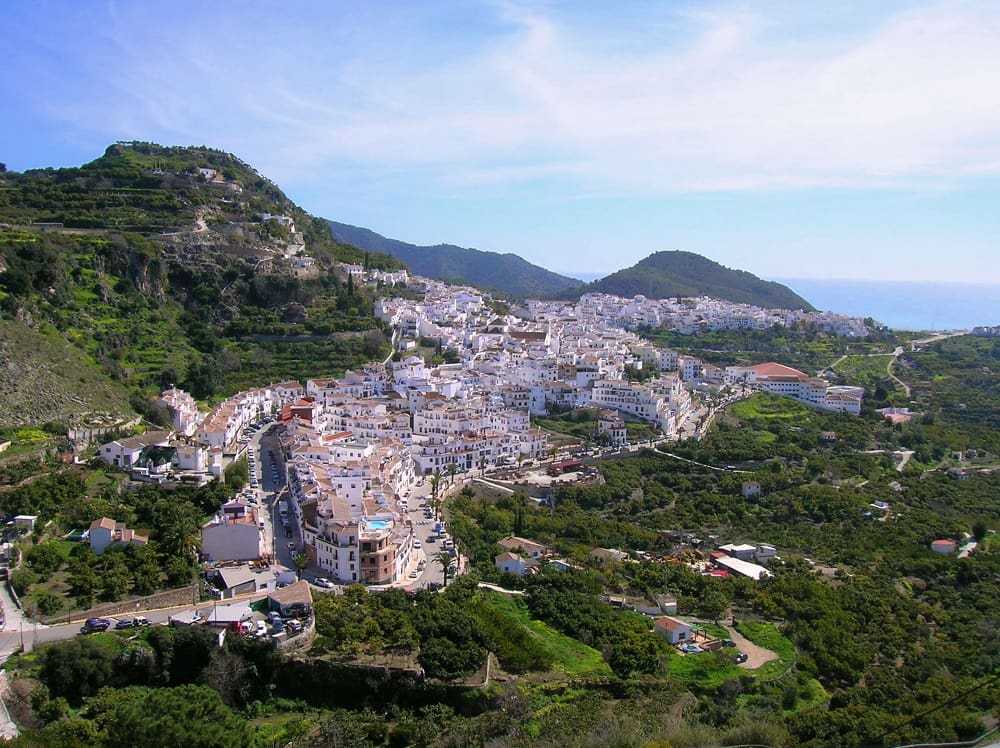

But there’s more to Frigiliana than just its picturesque charm. The village is a living testament to history. It’s been around for ages, witnessing the rise and fall of civilizations and the daily lives of its inhabitants. With each dawn and dusk, Frigiliana adds another page to its rich narrative, making it not just a beautiful destination but also a keeper of time’s many tales.
Stroll Through Frigiliana’s Enchanting Andalusian Streets
At the core of Frigiliana lies a captivating feature: its slender streets. Think of these streets as open-air art galleries. As you stroll, you’re surrounded by walls adorned with an array of plants and vivid flowers. Their colors pop against the backdrop of the village’s signature white walls. Every twist and turn beckons you to pause and immerse yourself in the surrounding beauty.
But there’s more to these streets than meets the eye. If you shift your gaze to the ground, you’ll discover another layer of art. The streets themselves are masterpieces, with detailed cobbled patterns underfoot. These designs aren’t random; they’re a testament to the village’s deep-rooted heritage. Each stone pattern weaves a tale, echoing the craftsmanship of artisans from yesteryears.
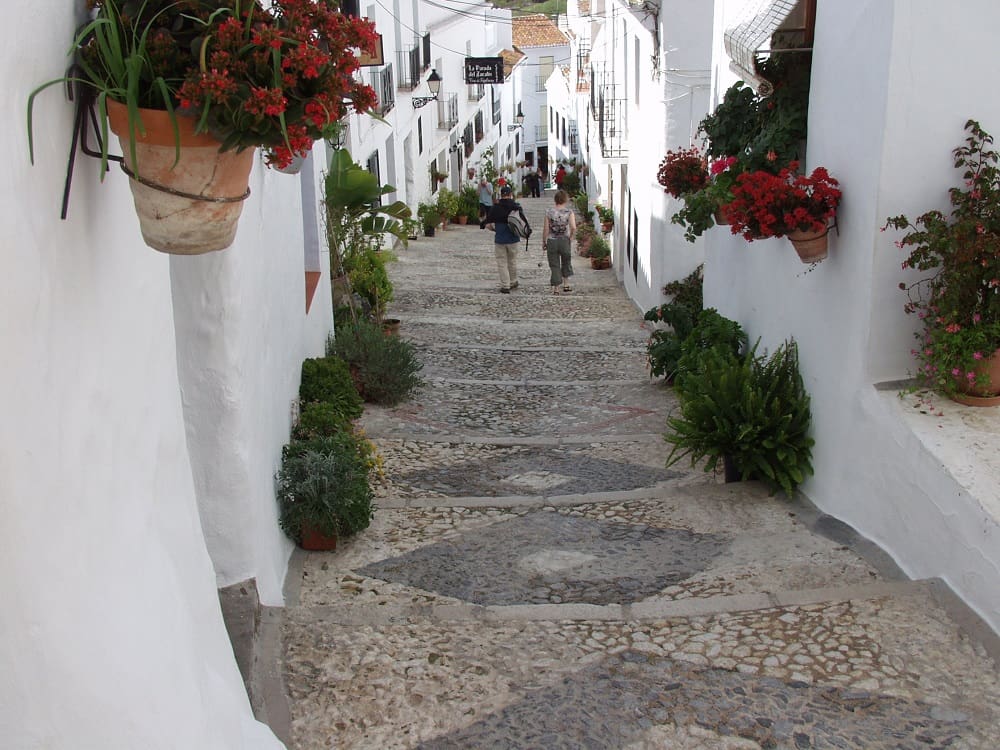

As you wander further, another charming feature of Frigiliana emerges: its fountains. Scattered throughout the village, these aren’t just ordinary water sources. They’re historical markers, each with its own design and story. Whether they’re ancient or more modern, these fountains are silent storytellers. They add to the village’s rich tapestry, making every visit to Frigiliana a journey through art, history, and nature.
Looking to Learn Spanish? We’ve Got You Covered
The Best Intensive Spanish Classes in the World’s Top Cities


Buenos Aires: Great City, Great Classes.


Malaga: Where Study Meets the Beach.
Embark on Your Spanish Classes Today: Click Here


Your Own City: Online Classes.
Embark on Your Online Spanish Classes: Click Here
Step Back in Time: Frigiliana’s Rich Moorish History
Wandering through Frigiliana’s captivating streets, you’ll stumble upon markers that whisper tales from the village’s rich past: the historical plaques. These aren’t just informative signs; they’re art pieces crafted from ceramic, each intricately designed to depict pivotal moments in Frigiliana’s timeline. Every plaque you encounter invites you to stop, read, and transport yourself to a bygone era. They serve as silent storytellers, weaving narratives of events and people that have shaped the village’s identity.
You can learn more about the Moorish in this blog: Moorish Architecture in Andalusian Cities: A Deep Dive
Yet, for those who crave a deeper dive into history combined with a touch of adventure, the Castle of Lizar awaits. This ancient fortress, now in ruins, stands proudly atop a hill, silently calling out to those eager to uncover its secrets. The journey to the castle is an adventure in itself. The path might test your endurance, but with every step, the anticipation builds. And the reward? Absolutely worth every moment. Once you reach the top, a panoramic spectacle unfolds. The horizon stretches endlessly, with the quaint village of Frigiliana resting below, bathed in the sun’s gentle embrace. Amidst the remnants of the castle, you can’t help but feel a connection to the past. The walls might be weathered, but they resonate with stories of ancient battles, noble defenders, and the passage of time, all set against the stunning backdrop of Andalusia’s vast landscapes.
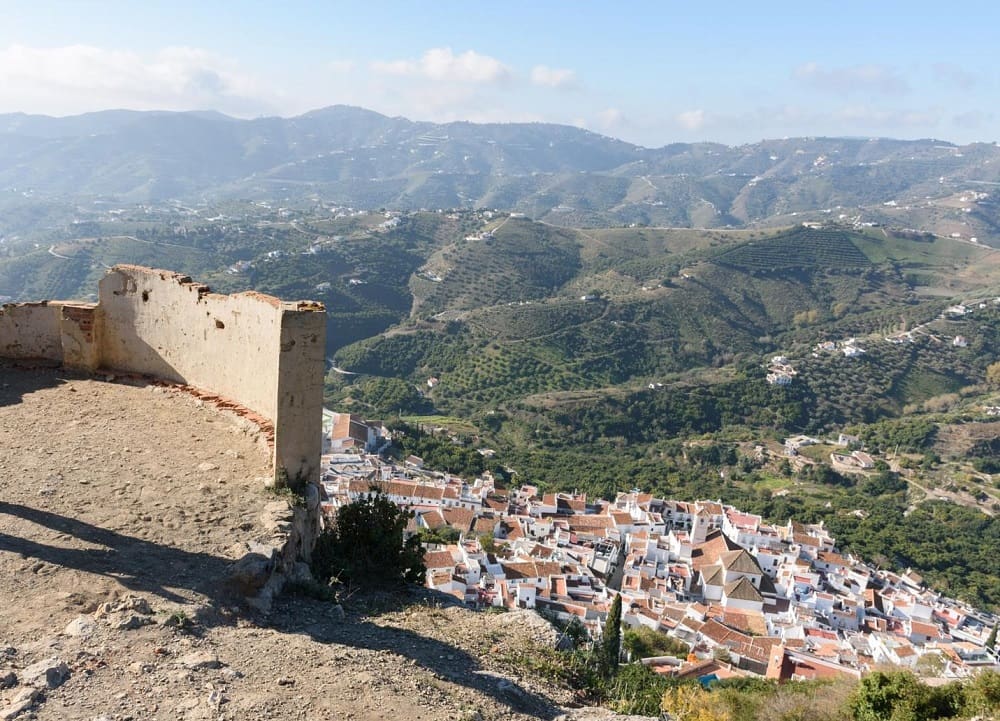

Marvel at Frigiliana’s Stunning Architectural Wonders
Nestled within Frigiliana’s maze of stone-paved pathways and quaint white-washed homes lies a monument echoing the village’s illustrious past: the Palacio de los Condes de Frigiliana. Locally known as “El Ingenio,” this majestic Renaissance-style edifice stands as a beacon of Frigiliana’s architectural heritage and its economic legacy. Beyond its grandeur and elegance, the palace whispers tales of its days as a thriving sugar factory. “El Ingenio” wasn’t just a building; it was the heartbeat of Frigiliana’s once-booming sugar trade. As you traverse its hallways, it’s easy to imagine the sounds of machines churning and the lively chatter of workers echoing through the ages.


Not far from the palace, another architectural gem beckons: the Church of Saint Anthony of Padua. More than just a place of worship, this church is a testament to Frigiliana’s rich blend of spiritual and artistic traditions. Erected in the 17th century, its walls and ceilings showcase the unique Mudéjar style, a harmonious blend of Christian and Moorish influences. Its bell tower, standing tall and proud, serves as a guiding light, drawing both the faithful and the curious. Stepping inside, one is enveloped in a tranquil atmosphere, a space where time seems to stand still, and stories of devotion, artistry, and community come to life.
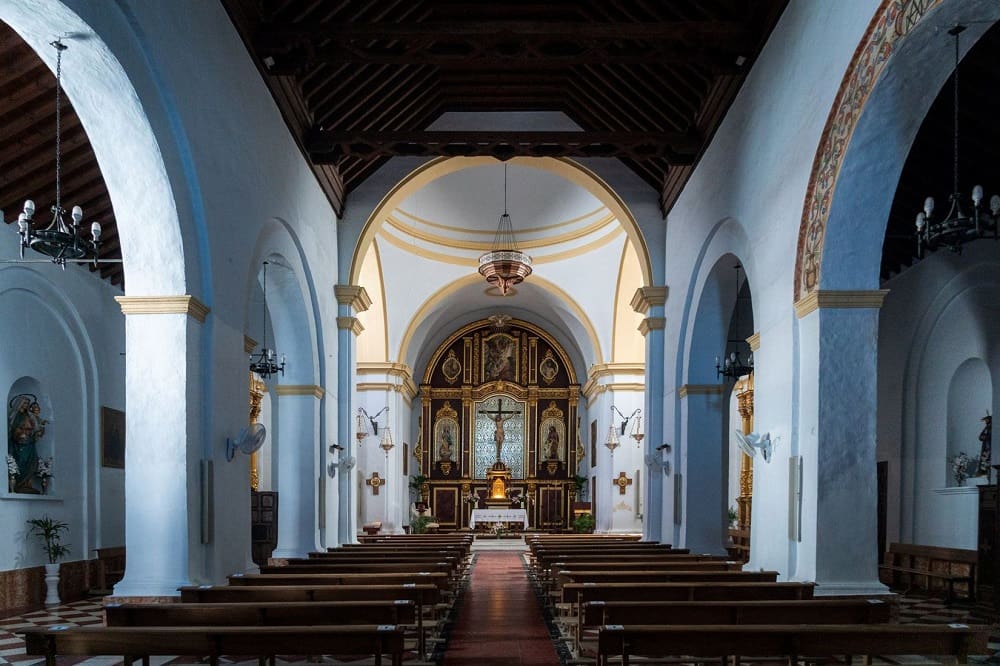

Both the Palacio and the Church are not just structures; they are living chronicles of Frigiliana’s vibrant tapestry of history. Each, in its own way, offers visitors a window into the village’s rich past, a journey through time, and a deeper understanding of the cultural mosaic that is Frigiliana.
Savor the Flavors: Frigiliana’s Authentic Local Cuisine
Nestled within the scenic confines of Frigiliana, amid its rich history and enchanting streets, lies a gastronomic haven waiting to be explored. The village, with its deep-rooted traditions, offers a culinary landscape as diverse and vibrant as its culture.
As you meander through the village’s cobbled pathways, you’ll be greeted by an array of dining establishments, each echoing the village’s essence in its own unique way. From cozy cafes hidden in the village’s nooks to grand restaurants boasting panoramic views of the Andalusian countryside, Frigiliana promises a culinary journey that tantalizes both the eyes and the palate.


Among the myriad of dining options, the Garden Restaurant emerges as a must-visit spot. It’s not just a place to eat; it’s a holistic experience. Set amidst a verdant backdrop, diners are treated to a visual feast of rolling hills and the distant glint of the Mediterranean Sea. The ambiance is one of tranquility, where nature’s melodies, from the whisper of the wind to the song of birds, enhance the dining experience.


However, the true magic of the Garden Restaurant lies in its culinary offerings. Renowned for its menu that’s both innovative and rooted in tradition, the restaurant is a testament to the art of fine dining. With a focus on fresh, local produce, every dish is a celebration of Andalusian flavors, presented with a modern twist. Whether you’re savoring a classic regional delicacy or indulging in a contemporary creation, the chefs at the Garden Restaurant craft each dish with passion and precision, ensuring that every bite is a journey of taste and texture.
Embrace the Natural Beauty of Frigiliana’s Scenic Landscapes
Nestled above the captivating village of Frigiliana, there’s a vantage point that offers an unparalleled view of the region’s splendor: the Mirador de Santo Cristo. This observation deck, thoughtfully positioned, gifts visitors with a sweeping 180° panorama that embodies the spirit of Andalusia. Standing there, one’s eyes dance across undulating hills peppered with Frigiliana’s signature white houses, shimmering under the sun’s embrace. These pristine structures create a striking visual against the vast expanse of the Mediterranean Sea, which lies majestically in the backdrop. Adding to this visual symphony are the bursts of color from flowers that grace many a balcony and terrace in the village. The entire scene, viewed from the Mirador de Santo Cristo, is a testament to Frigiliana’s enchanting beauty, making it an essential stop for every traveler.


For those with an adventurous spirit and a desire to delve deeper into the region’s natural allure, the Frigiliana River Walk, also known as Rio Chillar, beckons. This isn’t merely a scenic stroll; it’s an expedition through some of Andalusia’s most scenic terrains. The route meanders through a mesmerizing gorge, with the soothing sounds of the Rio Chillar river as your constant companion. Its cool waters provide a welcome relief, particularly during the sun-soaked summer days. As you journey onward, branching hiking trails invite you to explore further, leading you into the verdant embrace of nature. Surrounded by lush foliage and serenaded by the songs of local birds, these trails offer a rare chance to experience the region’s diverse ecosystem firsthand.
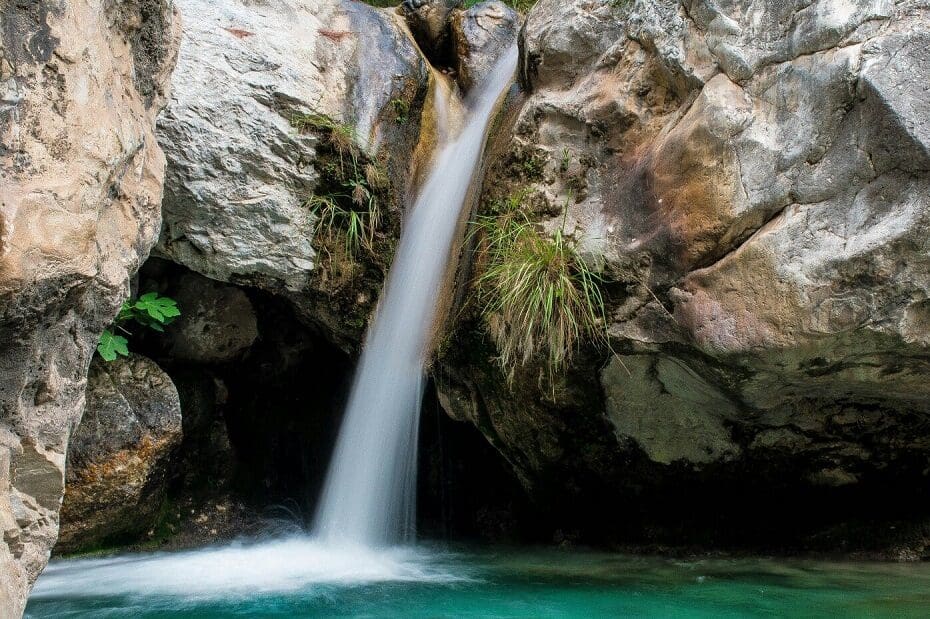

Explore Beyond: Day Trips and Attractions Near Frigiliana
A stone’s throw away from the charming village of Frigiliana lies a subterranean marvel that has fascinated countless visitors: the Nerja Caves. Hidden beneath the earth, this vast cave system unveils a series of chambers, each revealing nature’s artistry in the form of stalactites and stalagmites. As you delve deeper into the caves, the grandeur of these formations becomes increasingly evident, showcasing nature’s ability to craft wonders over millennia. Yet, the Nerja Caves are not just a testament to geological wonders. Within their shadowy recesses lie some of the oldest artworks known to humanity. These prehistoric paintings, estimated to be tens of thousands of years old, provide invaluable insights into the lives of early humans, making the caves a significant archaeological site.
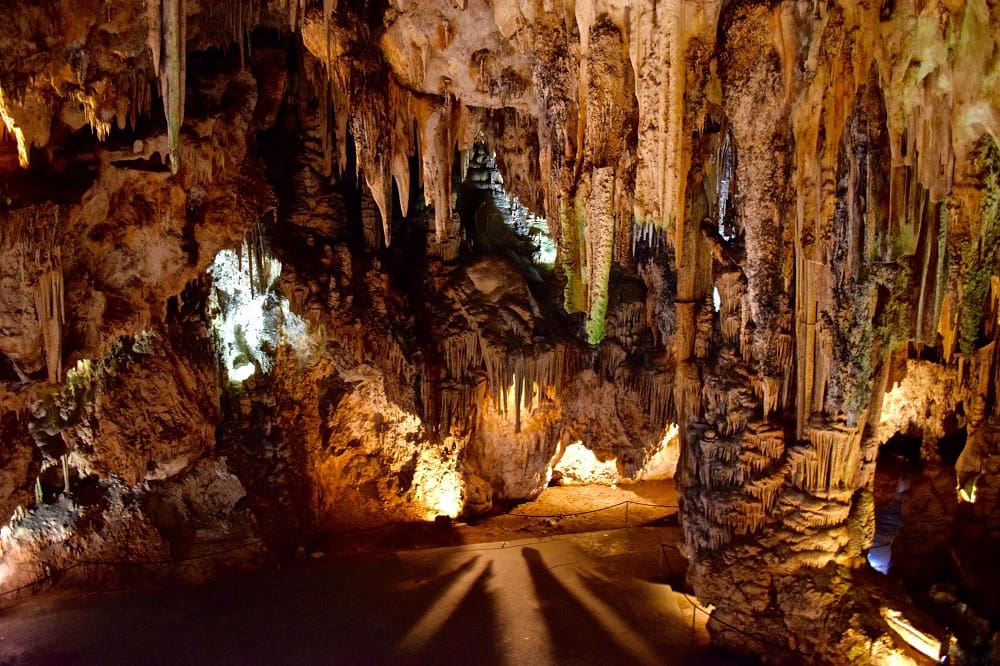

Further ahead, the coastal town of Nerja awaits exploration. Often dubbed the Aquamarine of the Costa del Sol, Nerja seamlessly blends age-old allure with contemporary vibrancy. Meandering through its narrow lanes, one is greeted by white houses, their facades adorned with blossoming flowers, leading to lively squares. The town is peppered with cafes, boutiques, and eateries, each echoing the essence of Andalusian culture. Yet, among Nerja’s many attractions, the Balcony of Europe stands out. Positioned on a cliff edge, this vantage point offers breathtaking views of the expansive Mediterranean, its blue expanse merging with the horizon.
You can learn more about Nerja in this blog: Experience the Magic of Nerja


For those with a penchant for further exploration, the neighboring town of Torrox beckons. Renowned for its historical depth and cultural richness, Torrox is a tapestry of Moorish designs interwoven with Spanish traditions. Its streets, reminiscent of those in Frigiliana and Nerja, are a delightful maze of white structures, historic places of worship, and bustling marketplaces. Whether history, gastronomy, or coastal relaxation is your calling, Torrox promises a diverse array of experiences.
You can learn more about Torrox in this blog: Your Ultimate Guide to Torrox


Join the Festivities: Celebrating Frigiliana’s Local Events
Nestled in the core of Andalusia, Frigiliana is a village that wears its heart on its sleeve, especially when it comes to celebrating its rich cultural heritage. Beyond its scenic streets and age-old landmarks, Frigiliana is a hub of vibrant festivities that span the calendar. Throughout the year, the village resonates with jubilant melodies, the streets burst into a riot of colors, and the community comes together in joyous celebrations, each echoing the traditions and stories that have been passed down through generations.
As the first rays of the new year touch the village, Frigiliana gears up for the enchanting Three Kings parade in January. Deeply entrenched in Spanish lore, this event transforms the village into a wonderland of twinkling lights and festive decor. The air is thick with anticipation as children, their faces glowing with excitement, line up along the pathways, waiting for the grand procession of the Three Kings. The parade itself is a spectacle – floats intricately designed, musicians playing soulful tunes, and dancers moving to rhythms that have echoed through the ages. This event is more than just a parade; it’s a harmonious blend of religious reverence and communal celebration, signaling the culmination of the festive Christmas period and ushering in a year brimming with promise and festivity.


Yet, the spirit of celebration in Frigiliana is not confined to just the winter months. As seasons change and the village basks in the warmth of summer, it prepares for one of its most iconic events: the Festival of the 3 Cultures in August. This festival is a vibrant tapestry of Frigiliana’s multifaceted heritage, paying homage to the Christian, Jewish, and Moorish roots that have intricately woven the village’s cultural and historical fabric. For days on end, every nook and corner of Frigiliana buzzes with activity – melodious tunes fill the air, theatrical performances narrate tales of yore, and the streets are lined with stalls where artisans proudly display their crafts. Culinary aficionados can indulge in a gastronomic journey, savoring delicacies that tell tales of the region’s rich culinary traditions. This festival, in essence, is a celebration of unity in diversity, a reflection of Frigiliana’s enduring spirit of inclusivity and its cherished legacy.


Discover Artistry and Unique Finds: Shopping in Frigiliana
Tucked away in the undulating landscapes of Andalusia, Frigiliana emerges as a sanctuary for not just those who cherish history or the serenity of nature, but also for connoisseurs of art. This quaint village, characterized by its gleaming white structures and age-old stone pathways, is more than just a picturesque locale; it’s a pulsating hub of creativity. The village resonates with the artistic expressions of a community of artists who have chosen to call Frigiliana their muse and home.
A stroll through its meandering lanes offers a visual treat. The very essence of Frigiliana seems to be painted with strokes of artistic flair, with every corner echoing the village’s vibrant creative spirit.
For visitors, one of the most enchanting aspects of Frigiliana is the chance to immerse themselves in its artisanal offerings. The village is dotted with quaint boutiques and workshops, many helmed by the artists themselves. These spaces are akin to Aladdin’s cave, brimming with one-of-a-kind creations that range from meticulously crafted ceramics to handwoven textiles, bespoke jewelry, and beyond.


Ceramics, especially, are emblematic of Frigiliana’s artistic heritage. Local ceramists, drawing from the village’s rich tapestry of cultures and the breathtaking natural vistas that envelop it, produce pieces that are a harmonious blend of form and function. Be it an ornately decorated bowl, an elegant pitcher, or a mural that captures the essence of Andalusia, each ceramic creation is a testament to the artisan’s dedication and prowess.
Yet, the artistic repertoire of Frigiliana extends beyond just pottery. Delve deeper into its artisanal shops, and you’ll discover a plethora of handcrafted treasures. From textiles that weave tales of ancient traditions to wooden masterpieces sculpted with finesse, the handiwork of Frigiliana’s artisans is evident in every artifact.
To shop in Frigiliana is to embark on an odyssey through its artistic soul. Every item you pick up is not just a memento of your journey but a piece of the village’s heart. And with each purchase, you’re not just acquiring an object; you’re celebrating and sustaining the legacy of Frigiliana’s vibrant community of artists, ensuring that their crafts and stories continue to flourish for generations to come.


Dive Deeper: Unraveling the Layers of Frigiliana’s Past
Nestled deep within the captivating lanes of Frigiliana, surrounded by its quaint houses and echoes of history, stands a beacon of the village’s illustrious past: the Museo Arqueológico – Casa del Apero. This museum, set within a meticulously preserved edifice, is a living testament to the myriad epochs that have woven the intricate tapestry of Frigiliana’s history.
Upon entering the Museo Arqueológico, visitors are ushered into a time capsule. The museum, with its thoughtfully arranged displays, charts the evolution of Frigiliana, beginning from the enigmatic Neolithic era and journeying through the sands of time to the contemporary age. Every exhibit, be it a timeworn relic, an ornate shard of pottery, or a parchment bearing tales of yore, serves as a narrative of the diverse communities that have graced this village with their presence.


What sets this museum apart is its portrayal of the rich mosaic of cultures that have intertwined their destinies with Frigiliana. From the pioneering inhabitants and the profound Moorish legacy to the epoch of the Christian Reconquista and the unfolding of modern narratives, the museum offers a kaleidoscopic view of a village that has perennially been a melting pot of civilizations.
The Casa del Apero, the venerable structure that cradles the museum, is itself steeped in history. Its robust stone facades and architectural nuances bear witness to its varied roles over the centuries, having transitioned from a storied granary to a hub of governance. Its reincarnation as a museum ensures that it remains an enduring custodian of Frigiliana’s cherished memories.


Find Your Zen: Relaxing Spots in Frigiliana
Nestled among the historic allure and stone-paved pathways of Frigiliana, tourists are presented with a delightful blend of traditional and modern means to traverse the village’s scenic vistas: the quaint touristic train and the agile tuk-tuks. These transport options, each distinct in its essence, promise every traveler an immersive journey through Frigiliana’s rich tapestry, ensuring that the village’s splendors are accessible to all, irrespective of their physical stamina or pace preferences.
The touristic train, with its rhythmic chugging and breezy carriages, is especially beloved by families and those desiring a laid-back exploration. As it meanders through the village’s labyrinthine streets, passengers are regaled with sweeping views of Frigiliana’s emblematic white houses, balconies bursting with floral hues, and time-honored edifices. The train’s leisurely tempo is perfect for those wishing to snap photos, absorb the insightful audio guide, or simply lose themselves in the village’s mesmerizing aura.


Conversely, the tuk-tuks, characterized by their compact structure and open-air design, offer an exploration that’s both intimate and adaptable. These motorized rickshaws, often helmed by locals brimming with tales and trivia, have the advantage of accessing the village’s more secluded nooks and crannies. Whether one’s interest lies in delving into a specific historical quarter, making a beeline for a renowned monument, or just soaking in Frigiliana’s ambiance, the tuk-tuks stand ready to tailor the journey to individual whims.
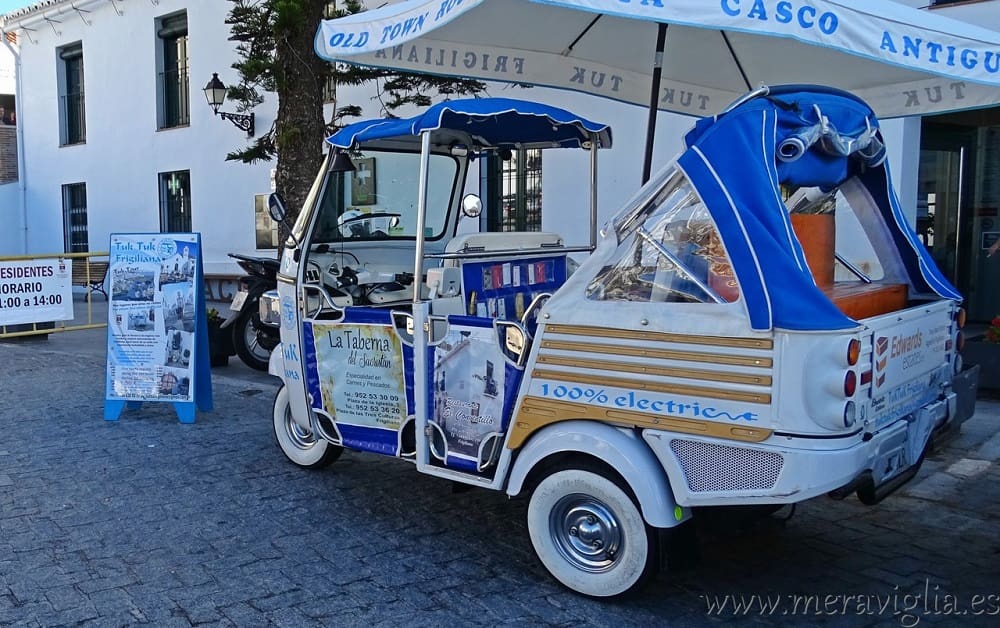

Both the nostalgic charm of the touristic train and the dynamic versatility of the tuk-tuks ensure that every visitor can bask in Frigiliana’s wonders without the fatigue of trekking, particularly during the sun-drenched summer days. These modes of transport thoughtfully cater to a diverse audience, from the elderly or those with mobility concerns to families with spirited toddlers, or simply anyone yearning for an unconventional and relaxed sightseeing experience.
Experience the Charm: Exploring Frigiliana’s Modern Side
Nestled in the heart of Andalusia, Frigiliana stands as a testament to the passage of time and the confluence of cultures. This village, steeped in history and brimming with life, is distinctly divided into two contrasting sections: the ancient and the contemporary. Each segment, with its individual allure and stories, offers visitors a multifaceted glimpse into the essence of Frigiliana, making it a quintessential destination in the Andalusian landscape.
The older section of Frigiliana is akin to stepping into a time capsule. As you navigate its serpentine, stone-laid pathways, there’s an overwhelming sense of being whisked away to a bygone era. This part of the village, characterized by its quintessential white houses festooned with a riot of blossoms, radiates a timeless charm. The Moorish legacy is evident at every turn, with beautifully crafted tiles, ornate arches, and secluded courtyards serving as reminders of the Moorish epoch. This section is a living museum, where venerable churches, squares, and edifices whisper tales from centuries past. The vistas from this part are nothing short of poetic, offering expansive views of undulating hills and the azure embrace of the Mediterranean.


Conversely, the newer section of Frigiliana presents a vibrant tapestry of the old and the new. While it upholds the village’s architectural ethos, this area is a hub of modern-day activities and interactions. Trendy cafes, avant-garde art spaces, and chic boutiques punctuate the streets, reflecting the contemporary pulse and ethos of Frigiliana. This part resonates with dynamism, as locals and tourists converge, exchange anecdotes, and revel in the plethora of experiences on offer. The perspectives from this section are diverse, showcasing a harmonious blend of the historic village core and the sprawling beauty of the surrounding terrains.


To truly grasp the soul of Frigiliana, traversing both its sections is imperative. The ancient quarter offers introspection, reverence, and a deep connection to history, while the modern segment throbs with vitality, innovation, and the anticipation of what lies ahead.
Frigiliana is more than just a picturesque village; it’s a testament to history, culture, and the harmonious coexistence of different civilizations. As you explore, you’ll not only be captivated by its beauty but also by the stories it has to tell.






